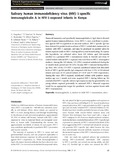Salivary human immunodeficiency virus (HIV)-1-specific immunoglobulin A in HIV-1-exposed infants in Kenya
Date
2008Author
Farquhar, C
Cott, T Van
Bosire, R
Bermudez, C
Type
ArticleLanguage
enMetadata
Show full item recordAbstract
Humoral immunity, and specifically immunoglobulin A (IgA) that is directed against human immunodeficiency virus (HIV)-1, may contribute to protection against HIV-1 acquisition at mucosal surfaces. HIV-1-specific IgA has been detected in genital tract secretions of HIV-1-uninfected commercial sex workers with HIV-1 exposure, and may be produced in parotid saliva by infants exposed orally to HIV-1 during delivery and breastfeeding. To explore this hypothesis, we collected saliva from 145 infants aged ≤ 6 months enrolled in a perinatal HIV-1 transmission study in Nairobi and from 55 control infants without HIV-1 exposure who were born to HIV-1-seronegative mothers. Among the 145 infants, 115 (79%) remained uninfected during the 12-month study period and 30 (21%) became HIV-1-infected during follow-up. Nine (8%) of the 115 HIV-1-exposed, uninfected infants had detectable levels of HIV-1 gp160-specific IgA compared with four (13%) of 30 infected infants and none of 55 control infants (P = 0·47 and P = 0·03 respectively). Among the nine HIV-1-exposed, uninfected infants with positive assays, median age was 1 month and none acquired HIV-1 during follow-up. We conclude that HIV-1-specific salivary IgA responses may be generated by very young infants exposed perinatally to maternal HIV-1. Mucosal responses would be an appropriate target for paediatric vaccines against breast milk HIV-1 transmission.
Citation
Clin Exp Immunol. 2008 July; 153(1): 37–43.Publisher
Department of Paediatrics
Description
Full text
Collections
- Faculty of Health Sciences (FHS) [10387]
- Journal Articles [329]

